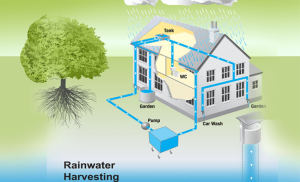Rooftop Rainwater Harvesting: its 4 Components, Need, & Benefits
The rooftop rainwater harvesting is a method from which rainwater is captured from the roof catchments which is then stored in reservoirs and by adopting artificial recharge techniques to meet the household needs through storage in tanks, harvested rainwater can be stored in the sub-surface groundwater reservoir.
The main purpose of rooftop rainwater harvesting is to make water available for future use and in dryland, hilly, urban and coastal areas capturing and storing rainwater for use is particularly important.

From rainwater, the practice of collecting rainwater can be classified into two categories such as;
- Land Based &
- Roof Based
Collecting rainwater runoff from roof surfaces which usually provides a much cleaner source of water that can be also used for drinking is called roof-based harvesting while collecting rainwater runoff from land surfaces is called land-based harvesting.
Application Areas:
In both new and existing buildings, rooftop rainwater harvesting systems can be installed and for different applications that do not require drinking water quality such as garden watering, toilet flushing, irrigation, laundry washing, and cleaning, harvested rainwater is used.
As a drinking water source, harvested rainwater is also used in many parts of the world and there is also less consumption of washing and cleaning powder because rainwater is very soft. The savings in potable water could amount up to 50% of the total household consumption with rainwater harvesting.
Components of Rooftop Rainwater Harvesting:
There are the following components in rooftop rainwater harvesting as given below;
- Catchment
- Transportation
- First Flush
- Filter
Catchment:
The catchment of the rainwater harvesting system is the surface that receives rainfall directly and it may be a courtyard, terrace, or unpaved or paved open ground.

The terrace may be a flat RCC or sloping roof or stone roof, so the area which actually contributes rainwater to the harvesting system is called catchment.
Transportation:
To take water pipes or drains to the storage/harvesting system rainwater from the rooftop should be carried down and water pipes should be UV resistant of the required capacity.

Through gutters and down take the pipe water from sloping roofs could be caught and the mouth of each drain should have wire mesh to restrict floating material at terraces.
First Flush:
The first flush device is used to avoid contaminating storable or rechargeable water by the probable contaminants of the atmosphere and the catchment roof and to flush-off the water received in the first shower.

During dry seasons it will also help in cleaning of silt and other material deposited on the roof and at the outlet of each drainpipe, provisions of first rain separators should be made.
Filter:
For the treatment of water to effectively remove turbidity, color, and microorganisms filters are used and water should pass through filters after the first flushing of rainfall.
On top of the storage tank gravel, sand, and netlon mesh filter are designed and placed and in keeping the rainwater in the storage tank clean this filter is very important because from entering the storage tank it removes silt, dust, leaves, and other organic matter.

After every rainfall event, the filter media should be cleaned.
Need for Rooftop Rainwater Harvesting:
There are the following needs for the rooftop rainwater harvesting such as;
- To meet the increasing demands for water and to reduce the runoff.
- Rooftop rainwater harvesting is used to avoid flooding of roads.
- It is important to control the decline of water levels and augment groundwater storage.
- To reduce groundwater pollution and improve the quality of groundwater.
- It’s important to reduce the soil erosion and during summer, drought, etc to supplement domestic water requirements.
Important Factors in Selection of Rainwater Harvesting:
There are the following factors which must be considered when selecting rooftop rainwater harvesting such as;
- Catchment area size and type.
- Weather patterns and local rainfall data.
- Drought period length.
- Alternative water sources and rainwater harvesting system cost.
Several factors should be taken into consideration when rainwater harvesting is mainly considered for irrigation such as;
- Evapotranspiration rates, rainfall amounts, and intensities.
- Depth of soil, Soil infiltration rate, water holding capacity, and fertility.
- Hydrogeology of the site and crop characteristics such as length of growing period and water requirement.
Benefits of Rooftop Rainwater Harvesting:
There are the following benefits of rainwater harvesting such as;
- Rainwater is a free source of water and relatively clean water.
- It provides a source of water when needed.
- It is environmentally responsible and is socially acceptable.
- It conserves water resources and promotes self-sufficiency.
- To landscape plants and gardens, rainwater is friendly.
- It reduces non-point source pollution and stormwater runoff.
- To maintain it uses simple, flexible technologies that are easy.
- After the proper treatment, it provides safe water for human consumption.
Disadvantages:
There are the following disadvantages such as;
- In times of dry weather or prolonged drought, it is not a dependable water source.
- In a low rainfall period, the system may not be able to provide water.
- The deterioration of load-bearing slopes is caused by leakage from cisterns.
- To public utilities, rainfall harvesting systems may reduce revenues.
